Secrets of growing peas in open ground and greenhouses
Growing and caring for peas in the open ground at the dacha or in a greenhouse will provide you with a tasty and healthy product and give you a lot of pleasant impressions. And the tips outlined in our article will help you get a good harvest and grow peas according to all the rules of agricultural technology.
Useful properties of the plant
While the taste and aroma of peas has been familiar to us since childhood, not everyone knows about its benefits.. But this is simply a storehouse of vitamins and minerals!
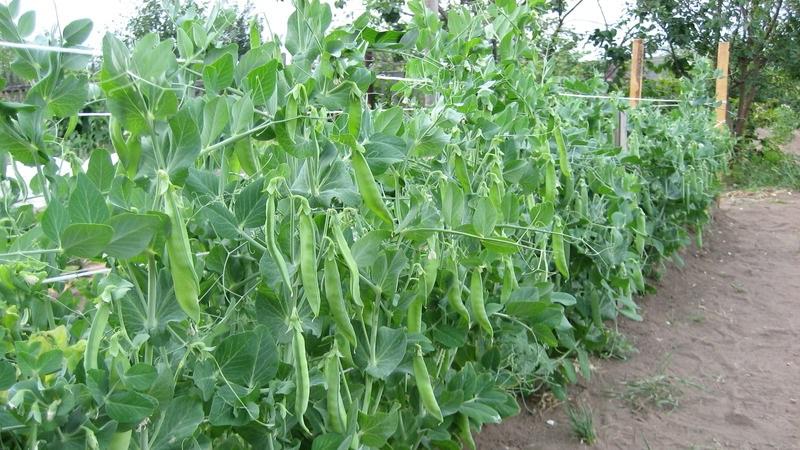
Judge for yourself:
- In terms of the level of vegetable protein in an easily digestible form for the body, peas are superior to all known vegetables, second only to soybeans and lentils;
- calorie content - 300 kcal per 100 g of product - corresponds to the average level of calorie content, therefore peas are recommended for people prone to obesity;
- the product will provide your cardiovascular system with zinc and magnesium, normalize blood cholesterol levels;
- the presence of potassium in the composition will improve the condition of those who suffer from swelling;
- calcium and phosphorus, which are responsible for the condition of teeth and bones, will ensure the prevention of osteoporosis;
- iodine will improve the functioning of the entire endocrine system;
- iron will eliminate the symptoms of anemia.
Important. 100 g of sprouted peas will provide your body with a daily dose of vitamin C.
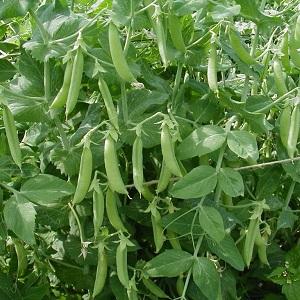 If you adore your dacha, then you will also be pleased learn about the usefulness of this culture for all dacha “inhabitants”:
If you adore your dacha, then you will also be pleased learn about the usefulness of this culture for all dacha “inhabitants”:
- there is no better source of nitrogen for young fruit trees than peas planted under their crowns;
- the plant gets along well with other garden crops, for example, carrots and corn, without depriving them of nutrients during the initial period of growth;
- After harvesting, the peas leave the summer resident an area enriched with nutrients, on which any garden plants will grow in comfortable conditions in the future.
Variety selection
Further We will decide on the variety that will best suit your needs. Gardeners prefer shelling and sugar pea varieties. The first is good for subsequent canning, the second has an excellent taste and is consumed fresh.
Both varieties include extra-early, early, main and late ripening crops. To keep peas in the garden all summer long, it is important not to make a mistake in choosing the variety.
More about peas:
How to properly grow seed peas
Pea planting technology
The yield of a crop largely depends on the preparatory stage, which includes choosing a site for planting, treating seeds and adhering to sowing dates.
Soil preparation
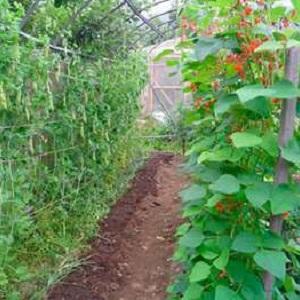 Where are peas grown? Any soil will do, including acidic soil, which should be limed before planting (250 g per 1 sq. m). The exception is areas with excess nitrogen content. This culture requires moderation in everything: sunlight, but without aridity, enough moisture, but the roots should not be constantly in water.
Where are peas grown? Any soil will do, including acidic soil, which should be limed before planting (250 g per 1 sq. m). The exception is areas with excess nitrogen content. This culture requires moderation in everything: sunlight, but without aridity, enough moisture, but the roots should not be constantly in water.
That's why It is not advisable to plant peas in shaded beds and in places with high groundwater levels. Thin stems also need protection from the wind. Suitable beds along the fence or under young trees, where they will not disturb anyone.
It is advisable to prepare the area for peas in the fall. The plant will greatly benefit from organic fertilizers applied to feed crops previously grown on this soil. In this case, it is enough just to dig up the ground and fertilize it with potassium salt (20 g) and superphosphate (50 g) per 1 square meter. m. Filled with moisture from melting snow, such a place in the spring will be ideal for a new “tenant”.
Important. Do not plant peas where legumes of any kind have already grown. This will reduce the crop yield and negatively affect the quality of the fruit.
Seed material
Growing peas from seeds or seedlings is a matter of your choice. Both germinated and dry seeds are suitable for sowing. It is important to pre-sort them, discarding sick and damaged ones.
The process will speed up if you use a saline solution (1 tablespoon of salt per 1 liter of water): healthy seeds will sink to the bottom.
To avoid infection of an adult plant with viral and fungal diseases, the seeds are first disinfected 1% potassium permanganate solution or 10% hydrogen peroxide solution for 7 minutes. The prepared material can be sown directly into the ground or germinated by wrapping it in a damp cloth.
Landing in the ground
How and when to plant pea seeds, depends on your views on the result of your labors.
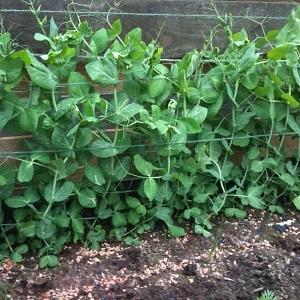 At the stage of planting seeds in the ground, it is important to consider the following points:
At the stage of planting seeds in the ground, it is important to consider the following points:
- light frosts (down to –6°C) are not scary for peas, so the twentieth of April is quite suitable for this procedure;
- if you plan to harvest throughout the summer, then sowing is done several times from April to July, about 2 times a month;
- select varieties with different ripening periods.
Sowing technology is simple. The seeds are placed to a depth of 3-5 cm in prepared grooves 15-20 cm wide, spaced 50-60 cm from each other. The distance between the seeds is 4-6 cm. The sown seeds are sprinkled with earth and compacted with light pressure from above.
Read also:
Features of plant care
Understanding the sequence of necessary actions will keep your peas healthy and ultimately ensure high yields.
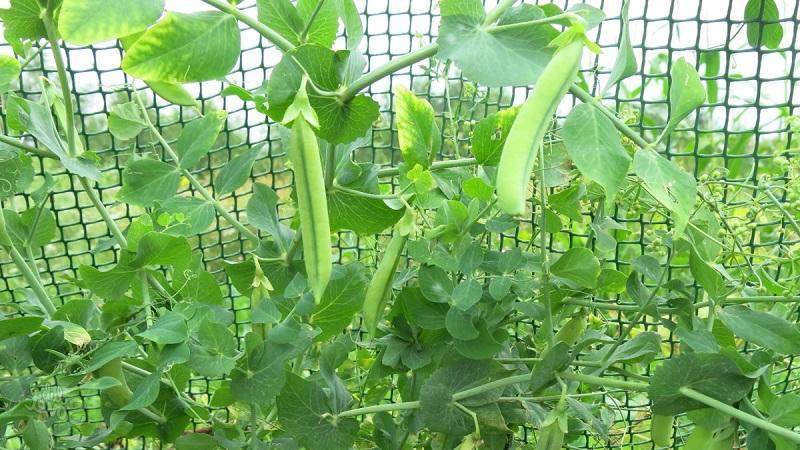
First steps after sowing
Expect the first shoots in a week. You need to take care in advance to protect the sprouts from birds. A transparent film or a small-sized mesh will solve the problem. And after another week, the usual dacha labor begins: loosen the soil, hill up the plants, pull out the weeds and water generously at least 2 times a week during the hot period.
Important. If you are interested in getting a good harvest, carefully pinch the top of the stem to encourage the side shoots of the plant to grow.
Features of feeding peas
Watering should be combined with not only loosening the soil and weeding, but also feeding the plant. Until the seedlings bloom, they need to be fed with mineral fertilizers twice a month. A solution of nitroammophoska (1 tablespoon per 10 liters of water per 1 sq. m) will provide the plants with nitrogen, phosphorus and potassium before watering.
In the future there will be no such need, since flowering plants independently provide themselves with everything they need, thanks to the activity of tuberous bacteria.
Important. It is better to carry out all manipulations in the evening or early in the morning, so that the hot sun does not burn the tender greens if moisture accidentally gets on the leaves.
Garter bushes
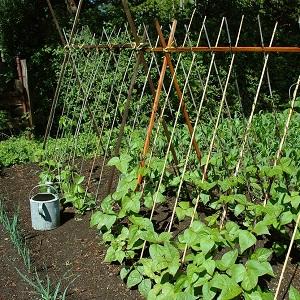 Our a vegetable needs support in the truest sense of the word. Crowding when planting is not contraindicated for peas: in the future, the young shoots will support each other. A culture growing nearby will become a good neighbor. For example, corn, with its dense stalk, creates support for thin, weak pea shoots.
Our a vegetable needs support in the truest sense of the word. Crowding when planting is not contraindicated for peas: in the future, the young shoots will support each other. A culture growing nearby will become a good neighbor. For example, corn, with its dense stalk, creates support for thin, weak pea shoots.
Bushes that have reached a height of 20–25 cm need garter. Gardeners are inventive in using available materials: wooden pegs and metal rods placed along a row and connected horizontally by stretched ropes perform the task perfectly. The pea vines spread over them are blown by the wind and warmed by the sun.
Important. Contact of the stem with the ground is detrimental to peas.
Ways to control pests and diseases
Are the leaves of the shoots curled and jagged edges appearing? Are there any necrotic spots on them? The mosaic virus has reached your vegetable.
The danger of the disease is that the diseased plant becomes a spreader of infection in the area, but it is impossible to cure it. If threatening signs are detected, the plant is dug up and burned, and the place where it grows is treated with a strong solution of potassium permanganate.
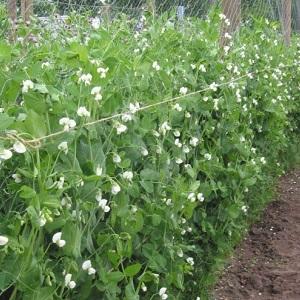 Peas are also susceptible to fungal diseases.. Spheroteca, or powdery mildew, ascochyta blight and pea rust are the most dangerous. If a whitish, loose coating in the form of a cobweb is noticed on the above-ground parts of the plant, followed by the formation of necrotic plaques on the leaves, it means that the fungus has already begun its destructive work. Inaction will lead to the death of the fruit.
Peas are also susceptible to fungal diseases.. Spheroteca, or powdery mildew, ascochyta blight and pea rust are the most dangerous. If a whitish, loose coating in the form of a cobweb is noticed on the above-ground parts of the plant, followed by the formation of necrotic plaques on the leaves, it means that the fungus has already begun its destructive work. Inaction will lead to the death of the fruit.
Fungicides successfully control fungal diseases. But you can get by with folk remedies.Spraying twice, at weekly intervals, with a solution of soda ash and grated laundry soap (40 g of each ingredient per 10 liters of water) will help. An infusion of field thistle soaked overnight (300 g of herb per bucket of water) is another effective remedy.
A little about pests
Larvae of codling moths, cutworms, and leaf rollers feed on flowers, leaves, and fruits of peas.. The nodule weevil also affects the roots of the plant.
Pea aphids settle on stems, feeding on its juices. Treatment with a daily infusion of chopped garlic (20 g per 10 liters of water) brings good results in pest control. Pollination with 12% hexachloran dust (2 g per 1 sq. m) is also effective, but less safe for humans.
Important. The best preventative measures in the fight against diseases remain seed treatment before planting and high garter of peas.
Fruit collection and storage
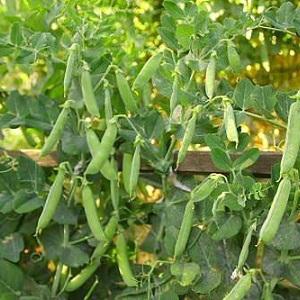 You will have to harvest peas much more often than you sowed them.: every 2-4 days from mid-June until the onset of persistent autumn cold snap. In the cool morning, holding the stem with your hand, carefully remove all the ripe pods from bottom to top, trying not to damage the plant.
You will have to harvest peas much more often than you sowed them.: every 2-4 days from mid-June until the onset of persistent autumn cold snap. In the cool morning, holding the stem with your hand, carefully remove all the ripe pods from bottom to top, trying not to damage the plant.
The bushes are cut off completely when the lower pods dry out.. They are tied into bunches and left to ripen in a suspended position in a dry, dark place. The tops are suitable for making compost. Leave the roots in the ground until autumn.
Peas are a perishable product, so you need to consider how to process them. Green peas can be canned or frozen. Dried in an oven or in a well-ventilated area, peas can be stored for years.
Important. For the regular and scrupulous collection of all ripe fruits, the plant will thank you with new flowering in August and fruiting throughout the warm autumn.
Conclusion
In order for the country harvest to be crowned with a rich harvest of peas, we will focus on the basic rules of its cultivation. Correctly selected varieties will ensure an uninterrupted supply of fresh product to your supplies throughout the summer. For sowing, choose a dry, wind-protected area on the sunny side. Properly prepare the soil and seeds for sowing: fertilize the soil in the fall, disinfect the seeds. Remember that when planting peas, they do not tolerate fresh organic matter and excess nitrogen at all.
Cold resistance is one of the advantages of the crop; it is not afraid of light frosts, so it can be planted already in April in soil that has dried out from spring floods. Do not let the plant creep along the ground: high and timely tying is the key to the health of your peas. Act at the first sign of disease or pest attack: this will protect your crop from destruction.